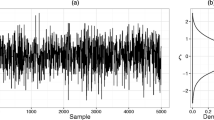Abstract
This article describes a Bayesian framework for estimation in item response models, with two-stage prior distributions on both item and examinee populations. Strategies for point and interval estimation are discussed, and a general procedure based on the EM algorithm is presented. Details are given for implementation under one-, two-, and three-parameter binary logistic IRT models. Novel features include minimally restrictive assumptions about examinee distributions and the exploitation of dependence among item parameters in a population of interest. Improved estimation in a moderately small sample is demonstrated with simulated data.
Similar content being viewed by others
References
Andersen, E. B. (1973).Conditional inference and models for measuring. Copenhagen: Danish Institute for Mental Health.
Andersen, E. B., & Madsen, M. (1977). Estimating the parameters of a latent population distribution.Psychometrika, 42, 357–374.
Ando, A., & Kaufman, O. M. (1965). Bayesian analysis of the independent normal process—neither mean nor precision known.Journal of the American Statistical Association, 60, 347–358.
Birnbaum, A. (1968). Some latent trait models and their use in inferring an examinee's ability. In F. M. Lord & M. R. Novick (Eds.),Statistical theories of mental test scores. Reading, MA: Addison-Wesley.
Bock, R. D., & Aitken, M. (1981). Marginal maximum likelihood estimation of item parameters: Application of an EM algorithm.Psychometrika, 46, 443–459.
Bock, R. D., & Mislevy, R. J. (1982). Adaptive EAP estimation of ability in a microcomputer environment.Applied Psychological Measurement, 6, 431–444.
Dempster, A. P., Laird, N. M. & Rubin, D. B. (1977). Maximum likelihood from incomplete data via the EM algorithm.Journal of the Royal Statistical Society (Series B),39, 1–38.
Dunsmore, I. R. (1976). Asymptotic predictor analysis.Biometrika, 63, 627–630.
Efron, B., & Norris, C. (1975). Data analysis using Stein's estimator and its generalizations.Journal of the American Statistical Association, 70, 311–319.
Fisher, G. (1973). The linear logistic test model as an instrument in educational research.Acta Psychologica, 37, 359–374.
Hartigan, J. A. (1983).Bayes theory. New York: Springer-Verlang.
James, W., & Stein, C. (1961). Estimation with quadratic loss.Proceedings of the Fourth Berkeley Symposium on Mathematical Probability and Statistics (Vol. 1). Berkeley: University of California Press.
Jeffreys, H. (1961).Theory of probability (3rd ed.) Oxford: Clarendon Press.
Kelley, T. L. (1927).The interpretation of educational of educational measurements. New York: World Press.
Leonard, T., & Novick, M. R.. (1985).Bayesian inference and diagnostics for the three-parameter logistic model (ONR Technical Report 85-5). Iowa City, IA: University of Iowa.
Lewis, C. (1985).Estimating individual abilities with imperfectly known item response functions. Paper presented at the meeting of the Psychometric Society, Nashville, TN.
Lindley, D. V., & Smith, A. F. M. (1972). Bayes estimates for the linear model.Journal of the Royal Statistical Society (Series B),34, 1–41.
Lord, F. M. (1952). A theory of test scores.Psychometrika Monograph No. 7,17(4, Pt. 2).
Lord, F. M. (1975).Evaluation with artificial data of a procedure for estimating ability and item characteristic curve parameters (RB-75-33). Princeton, NJ: Educational Testing Service.
Lord, F. M. (1980).Applications of item response theory to practical testing problems. Hillsdale, NJ: Erlbaum.
Mislevy, R. J. (1984). Estimating latent distributions.Psychometrika, 49, 359–381.
Mislevy, R. J. (in preparation).Stochastic test designs (Research Report). Princeton, NJ: Educational Testing Service.
Mislevy, R. J., & Bock, R. D. (1982).BILOG: Item analysis and test scoring with binary logistic models [Computer program]. Mooresville, IN: Scientific Software.
Mislevy, R. J., & Bock, R. D. (1985). Implementation of anEM algorithm in the estimation of item parameters. In D. J. Weiss (Ed.),Proceedings of the IRT/CAT Conference. Minneapolis, MN: Computerized Adaptive Testing Laboratory, University of Minnesota.
Morgan, G. (1985).Computing approximate marginal distributions in the Rasch logistic test model using prior information. Paper presented at the annual meeting of the American Educational Research Association in Chicago, IL.
Neyman, J., & Scott, E. L. (1948). Consistent estimates based on partially consistent observations.Econometrica, 16, 1–32.
Novick, M. R., Jackson, P. H., Thayer, D. T., & Cole, N. S. (1972). Estimating multiple regressions inm-groups: A cross-validational study.British Journal of Mathematical and Statistical Psychology, 5, 33–50.
O'Hagan, A. (1976). On posterior joint and marginal modes.Biometrika, 63, 329–333.
Rasch, G. (1960).Probabilistic models for some intelligence and attainment tests. Copenhagen: Danish Institute for Educational Research.
Reiser, M. R. (1981, June).Bayesian estimation of item parameters in the two-parameter logistic model. Paper presented at the annual meeting of the Psychometric Society in Chapel Hill, NC.
Rigdon, S., & Tsutakawa, R. K. (1983). Parameter estimation in latent trait models.Psychometrika, 48, 567–574.
Rubin, D. B. (1976). Inference and missing data.Biometrika, 63, 581–592.
Rubin, D. B. (1980). Using empirical Bayes techniques in the law school validity studies.Journal of the American Statistical Society, 75, 801–827.
Sanathanan, L., & Blumenthal, N. (1978). The logistic model and latent structure.Journal of the American Statistical Association.73, 794–798.
Stroud, A. H., & Sechrest, D. (1966).Gaussian quadrature formulas. Englewood Cliffs, NJ: Prentice-Hall.
Swaminathan, H., & Gifford, J. A. (1981).Bayesian estimation in the three-parameter logistic model. Paper presented at the annual meeting of the Psychometric Society, Chapel Hill, NC.
Swaminathan, H., & Gifford, J. A. (1982). Bayesian estimation in the Rasch model.Journal of Educational Statistics, 7, 175–192.
Swaminathan, H., & Gifford, H. A. (1985). Bayesian estimation in the two-parameter logistic model.Psychometrika, 50, 349–364.
Thissen, D. (1982). Marginal maximum likelihood estimation for the one-parameter logistic model.Psychometrika, 47, 175–186.
Wainer, H., & Thissen, D. (1982). Some standard errors in item response theory.Psychometrika, 47, 397–412.
Author information
Authors and Affiliations
Additional information
This research was supported by a grant from the Spencer Foundation, Chicago, IL. Comments and suggestions on earlier drafts by Charles Lewis, Frederic Lord, Rosenbaum, James Ramsey, Hiroshi Watanabe, the editor, and two anonymous referees are gratefully acknowledged.
Rights and permissions
About this article
Cite this article
Mislevy, R.J. Bayes modal estimation in item response models. Psychometrika 51, 177–195 (1986). https://doi.org/10.1007/BF02293979
Received:
Revised:
Issue Date:
DOI: https://doi.org/10.1007/BF02293979




